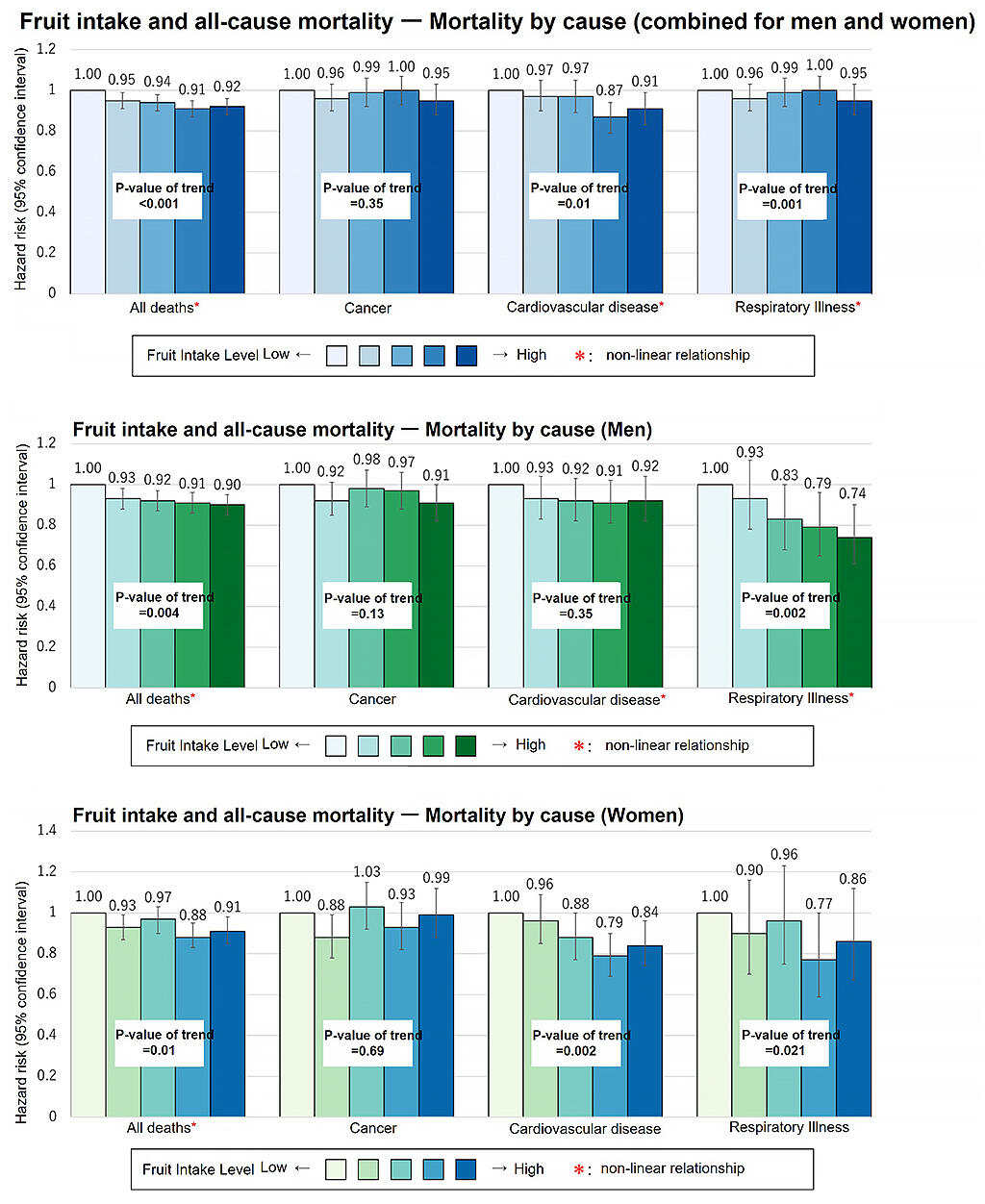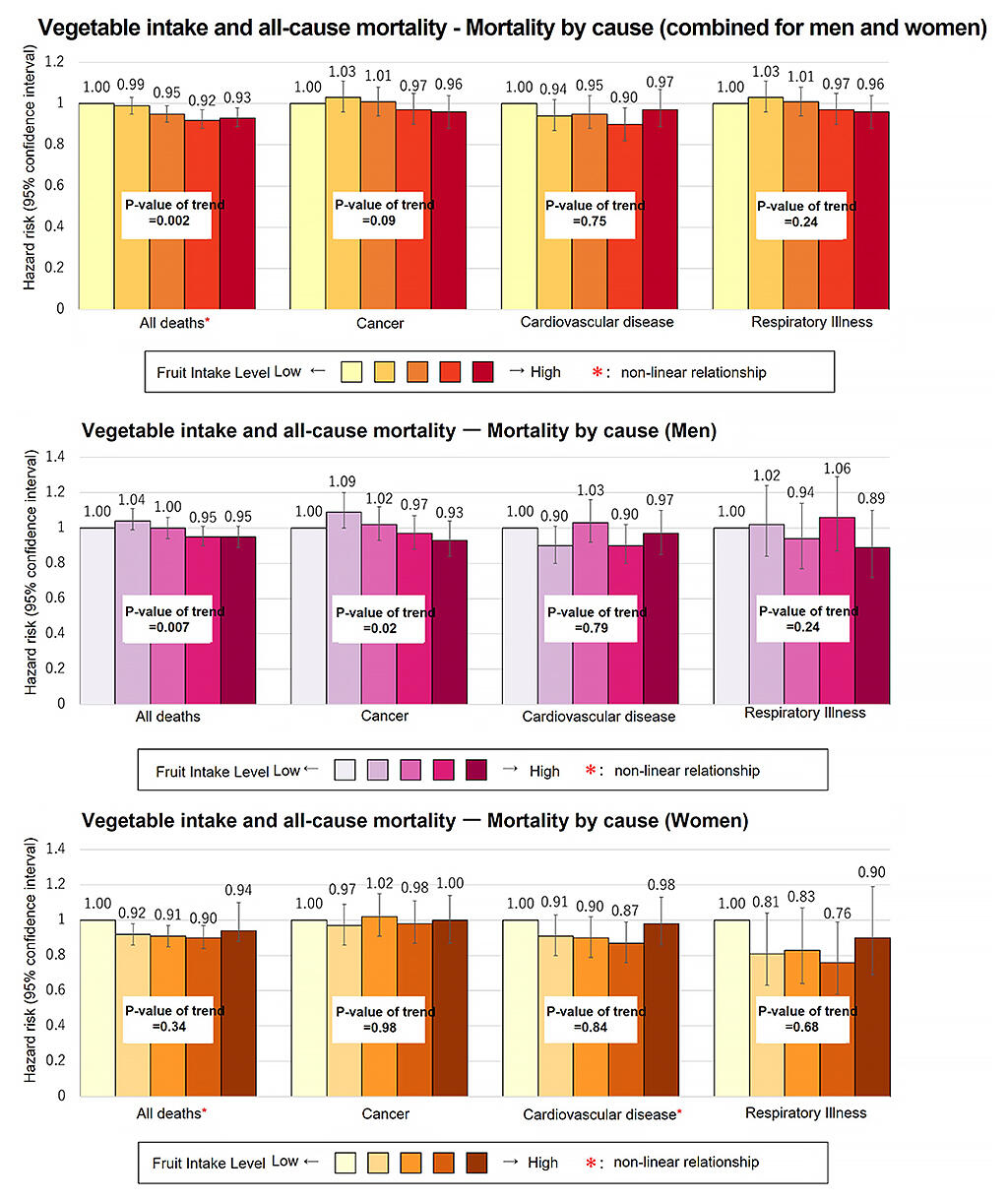The research group of Professor Atsushi Goto and graduate student Yuki Sahashi (currently a cardiology physician at Gifu University) of the Graduate School of Data Science, Yokohama City University, and the National Cancer Center Japan, in a large cohort study ("Research to establish evidence to benefit health maintenance and improvement including cancer prevention based on multipurpose cohort studies"), investigated the link between fruit and vegetable intake and the risk of all-cause mortality and specific-cause mortality. The results showed that the risk of all-cause mortality was lower in the group with high fruit and vegetable intake than in the group with low fruit and vegetable intake.

Provided by Yokohama City University

Provided by Yokohama City University
The study followed approximately 95,000 Japanese people for about 20 years. It investigated the relationship between fruit and vegetable intake and mortality risk among people aged 40 to 69 and who lived within the jurisdiction of 11 public health centers (as of 2019) in 1990 and 1993 in Ninohe City in Iwate Prefecture, Yokote City in Akita Prefecture, Saku City in Nagano Prefecture, Chubu region in Okinawa Prefecture, Katsushika Ward in Tokyo, Mito City in Ibaraki Prefecture, Nagaoka City in Niigata Prefecture, central-east Kochi Prefecture, Kamigoto City in Nagasaki Prefecture, Miyako Island in Okinawa Prefecture, and Suita City in Osaka Prefecture. Participants' daily intake of fruit and vegetables were calculated from a validated food intake frequency questionnaire and the participants were then grouped into quintiles to ensure that there was an equal number of people in each group. During the approximately 20 years of follows-ups, 20,387 deaths occurred. This included 8,274 cancer deaths, 5,978 cardiovascular deaths, and 1,871 respiratory disease deaths.
When compared to the group with the lowest fruit and vegetable intake, the cohort study found that the risk of all-cause mortality was about 8-9% lower and the risk of cardiovascular mortality was about 9% lower in the group with the highest fruit intake.
However, higher intake did not mean lower risk. In Japan, the Dietary Balance Guide (Ministry of Agriculture, Forestry and Fisheries and Ministry of Health, Labour and Welfare) recommends a daily vegetable intake of 350 grams or more and a fruit intake of about 200 grams per day, and Health Japan 21 (a national health promotion movement by the Ministry of Health, Labour and Welfare; 2nd edition) also sets a target of 350 grams or more per day. Although it is difficult to accurately estimate the amount of intake from the food intake frequency questionnaire used in the study, by applying the results obtained to more detailed dietary records of intake in some populations, it was considered beneficial to consume more than 300 grams of vegetables and 140 grams of fruits.
On the other hand, previous cohort studies, mainly in Europe and the United States, found that vegetable and fruit intake was also associated with lower cancer and respiratory disease deaths, but this study did not find those associations. Similarly, this cohort study may have found no association between vegetable and fruit intake and respiratory disease mortality because of the low number of respiratory disease deaths.
The different cancer incidence rates and the higher prevalence of infectious diseases as a cause of cancer among Asians compared to Europeans and Americans may also explain why no association was found between vegetable and fruit intake and cancer mortality. A cohort study in China similarly found no association between vegetable and fruit intake and cancer mortality. This suggests that further investigation of racial differences in the association between vegetable and fruit intake and risk of death is warranted.
According to Dr. Sahashi, "The idea was to present desirable vegetable and fruit intake amounts, and we were able to estimate these desirable intake amounts by applying the results obtained from the survey form to more detailed dietary record intakes in some populations. For future development, we would like to link this to efforts to increase vegetable and fruit intake, as many people in Japan are deficient in this area."
This article has been translated by JST with permission from The Science News Ltd.(https://sci-news.co.jp/). Unauthorized reproduction of the article and photographs is prohibited.




